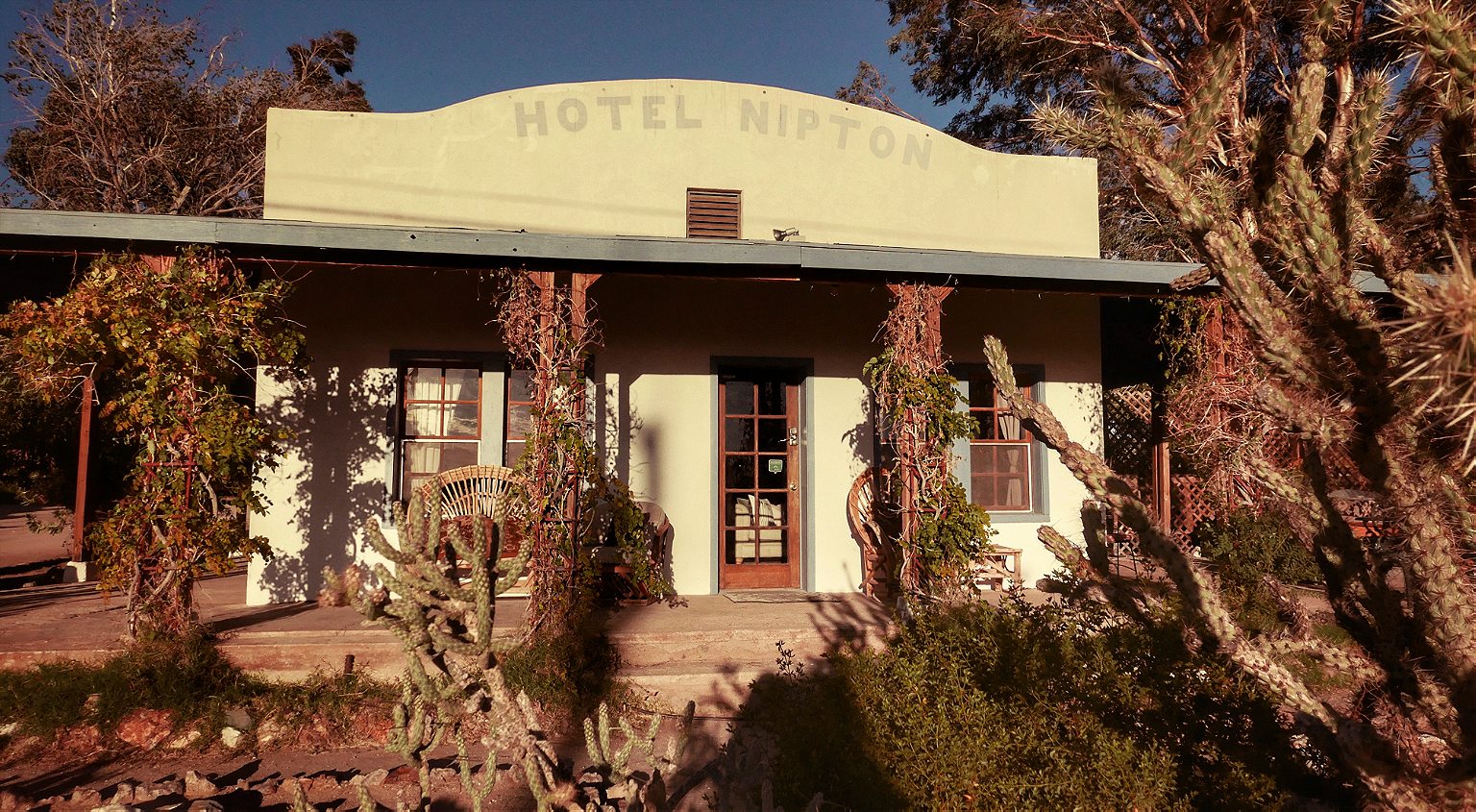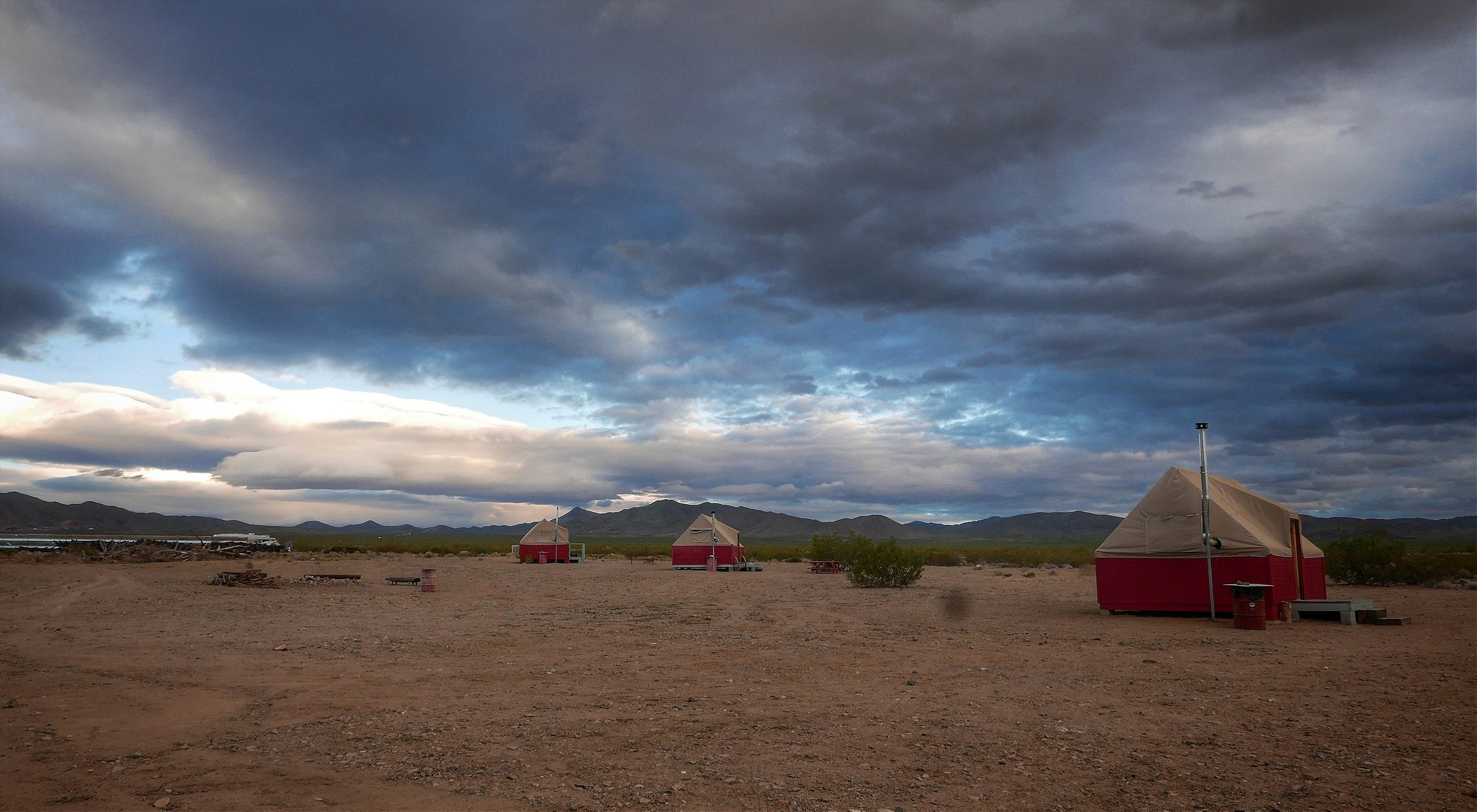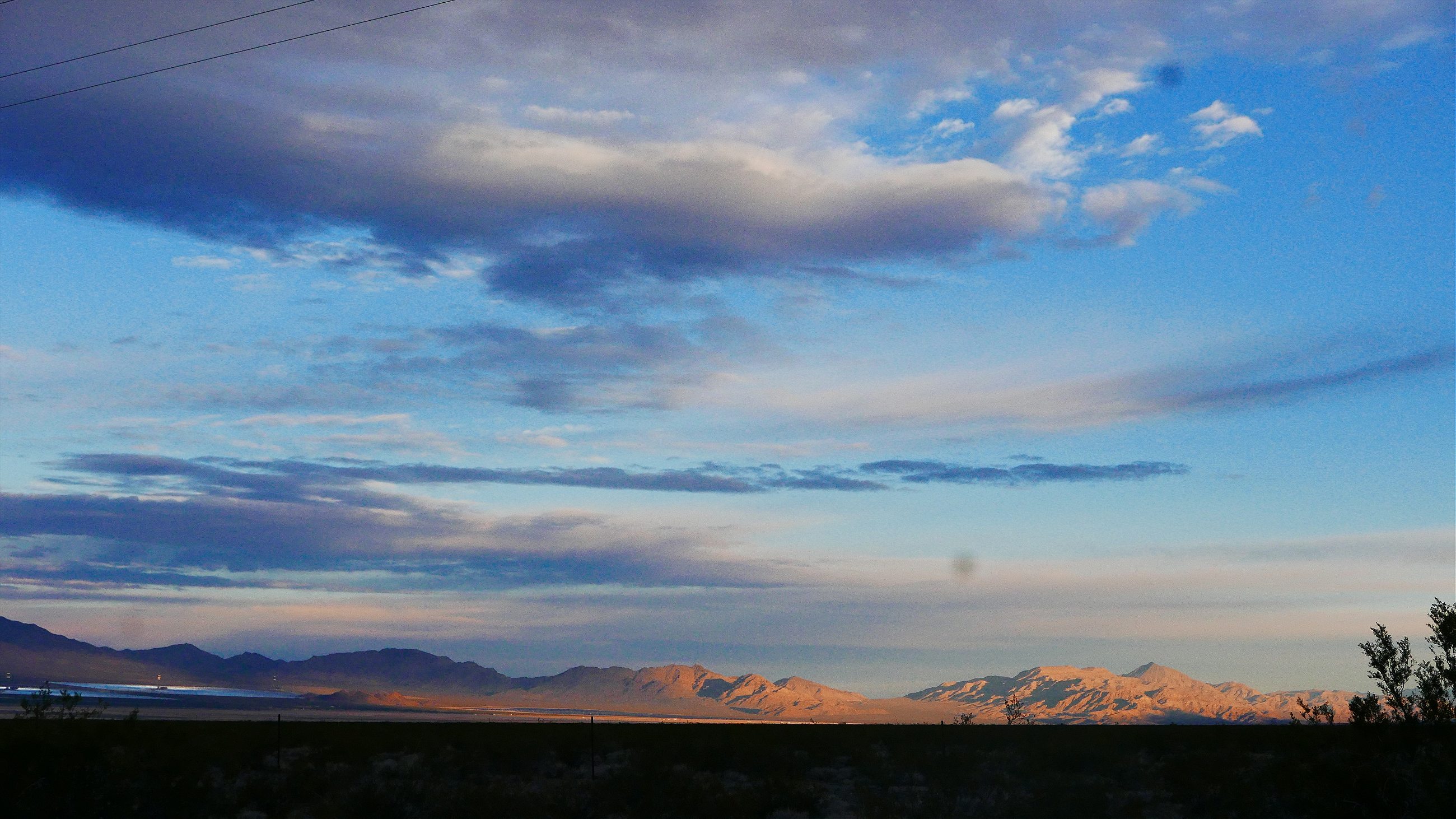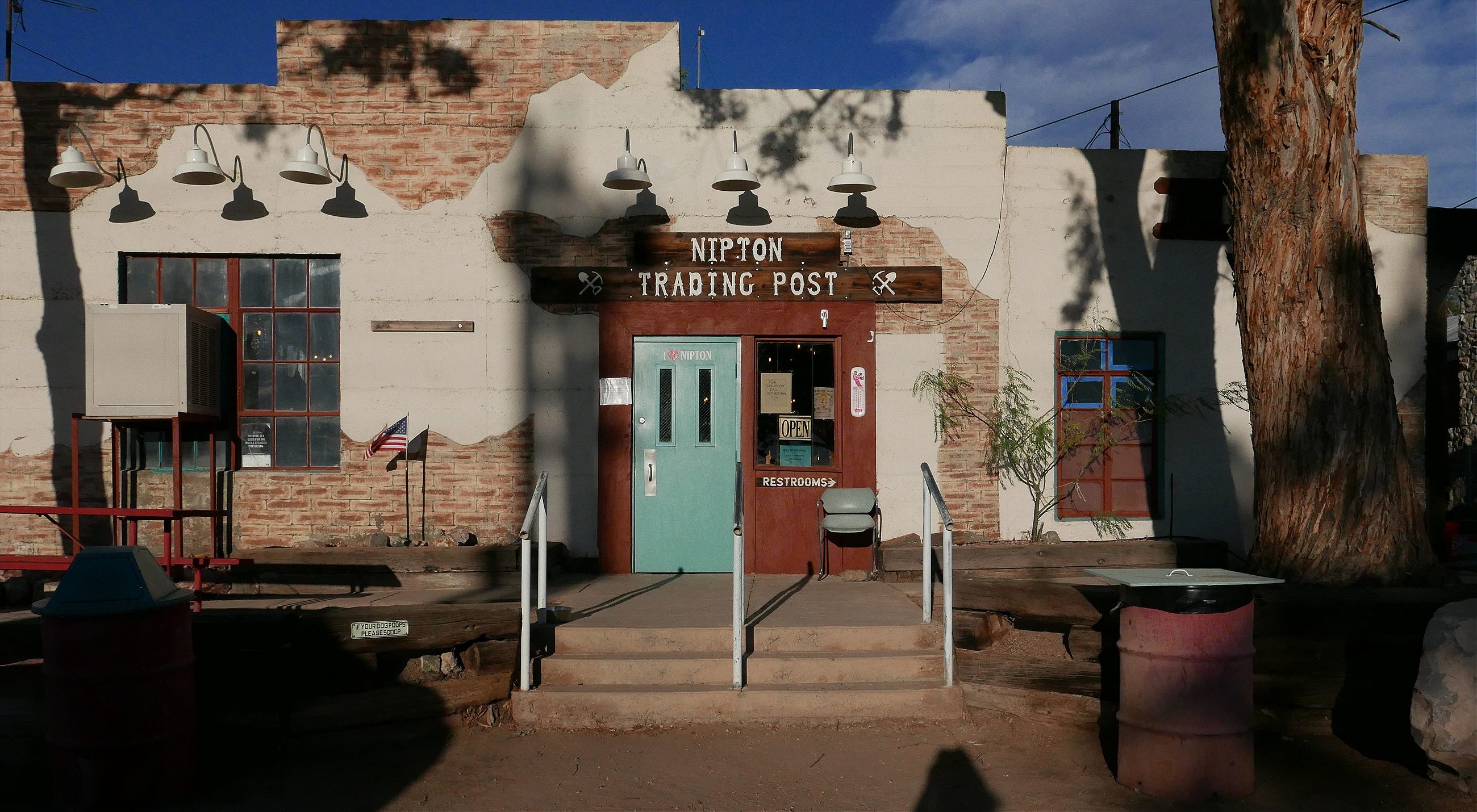The tiny mining town of Nipton is trying to transform itself once again: this time, into a marijuana destination nonpareil.
The first thing you notice in Nipton, California, is the silence. When the breeze picks up, you might hear leaves rustling in the distance or a rhythmic clang as the wind lifts a rope, then snaps it back down against a metal flagpole. But on a still day, you don’t hear anything. No cars, no voices, no birds, no airplanes, nothing.
The tattered outpost of about 20 residents sits on the bottom of a prehistoric lake bed on the northern edge of the Mojave National Preserve. Scrub brush stretches out for miles to the rim of the long-forgotten lake. On the horizon sit mountains that hold the only known dinosaur footprints in California. This valley—called Ivanpah, meaning sweet water in the Southern Paiute language—is so desolate that it inspired a post-apocalyptic wasteland backdrop in the video game Fallout: New Vegas.
The absence of sound is why the Union Pacific freight train is so jarring as it pierces the pristine silence. The train is so loud that guests of the town’s five-room adobe-style hotel are handed earplugs upon check-in.
“Did the train come through this morning? I have lived here so long I don’t even hear it anymore,” says Jim Eslinger, exploding into a fit of laughter. Eslinger is the town’s self-appointed “mayor.” A former long-haul trucker from Washington state, he has lived in Nipton for eight years—longer than any other current resident. Like many who have spent a large amount of time in this isolated town, Eslinger stumbled upon Nipton searching for gold.
“My friend wanted to find a river of gold he remembered seeing as kid somewhere in Nevada,” he says. “We searched for two months and didn’t find anything but this town. And now I am in paradise.”



Paradise for Eslinger is this little piece of unincorporated San Bernardino County, an hour south of Las Vegas and about two miles west of the Nevada state line. It is not so much a town as a pull-off on the side of the road. Just past the railroad track is a gravel parking lot next to the Nipton Trading Post, a general store that sells dry goods, refreshments, and guidebooks; the Whistle Stop Café; and the Nipton Hotel. Behind the hotel sits a handful of tented ecolodges. Residents live across the road in their trailers. There is no stop sign, no postal service, no gas station, not even a sidewalk. But that is all about to change.
In September, American Green, the largest publicly traded cannabis company in the United States, bought this tiny town in hopes of creating the country’s first cannabis-friendly, energy-independent hospitality destination. It plans to spend $2.5 million over the next 18 months transforming Nipton into a town that includes hundreds of hotel rooms, mineral baths, a craft brewery, farm-to-table dining experiences, a cannabis farm, artist-in-residence programs, and plenty of marijuana-related businesses, such as cultivators and glassblowers.
American Green also plans to build a production hub for cannabis-based products starting with bottling and distributing cannabidiol-infused water directly from a local aquifer. Cannabidiol—or CBD, as it is commonly known—is the nonpsychoactive part of cannabis that has anti-inflammatory and anti-anxiety properties but does not give users a high.
“We are excited to lead the change for a true ‘Green Rush,’” writes David Gwyther, president of American Green, in a statement. “The Cannabis Revolution that’s going on here in the U.S. has the power to completely revitalize communities, the same way gold did during the 19th century.”

Nipton is a lingering reminder of the era before the West was won. It started as the Nippeno mining camp in the late 1800s; nestled near two covered-wagon trail crossings, it was a perfect congregation point for miners and prospectors when gold was discovered in the area. In 1905, a railroad connecting Salt Lake City and Los Angeles—the brainchild of Nevada senator and copper baron William Clark—opened on the edge of the Nippeno Camp. Passengers from miles around traveled to the little Nippeno whistle stop with their freight and cattle to catch the train.
In 1913, Harry Trehearne, a Cornish miner from England, immigrated to America and settled in Nipton. He opened a general store, restored the Hotel Nipton, and dug the first water well. Under the Homestead Act of 1940, President Franklin Roosevelt transferred the title of Nipton to Trehearne, who held it until 1956. From 1956–84, the town passed through the hands of six owners. In 1984, Gerald Freeman, a Caltech-trained geologist prospecting for gold in the Mojave Desert, stumbled on the town and bought it for $200,000. At the time, Nipton’s sole resident lived in the trading post, selling refreshments to wayward travelers on their way to somewhere else.
Freeman had grand visions of transforming the ghost town into a self-sustained destination for nature lovers. He spent more than $1 million on organic-farming projects, a solar plant, building restoration, and a hydrogen system to store clean energy. He restored the early 1900s whitewashed adobe Hotel Nipton, reopened the Whistle Stop Café, and built Frank Lloyd Wright–inspired ecocabins.
The town slowly began attracting visitors. Motorcyclists would stop for a bite to eat at the Whistle Stop Café and sit on the porch to smoke a cigarette, foreigners wanting a taste of the Old West would stay a night or two at Hotel Nipton, and off-the-grid campers slowly making their way across the country would relax in the campgrounds. One of its biggest sources of revenue was lotto tickets. For years, the Nipton Trading Post was the closest California State Lottery retailer to Las Vegas, which meant that lines stretched out the door of the little convenience store, crowded with Nevada gamblers with no access to a state lottery hoping to win the big jackpot.
The Cannabis Revolution that’s going on here in the U.S. has the power to completely revitalize communities, the same way gold did during the 19th century.
—David Gwyther
In 2015, when Freeman’s health began to decline, he put the town up for sale for $5 million. Included in the price tag were 80 acres, an underground water source, the solar plant, the trading post, the hotel, ecocabins, an abandoned schoolhouse, and two small houses. He wanted to sell the town to someone who would keep his dream of creating a sustainable tourist destination alive, but he died before that happened, leaving the fate of the town’s sale up to his wife.
The few residents—somewhere between 15 and 25, no one knows for sure—who lived in town were nervous.
“I have lived all over the United States and there is no place like here,” Eslinger says.
It is a place where one can run around naked and “no one would give a shit,” says Eslinger. A place where the residents, most of whom are self-described “old hippies,” stop at the trading post to collect money and shopping lists from each other before driving an hour out of town for supplies. A place where no one worries about locking doors. A place so remote that the distractions of man are nonexistent, opening space for reflection and a feeling of true isolation.
“My biggest fear was that no one was going to buy it and it was all going to fall to the wayside. My nightmare was me turning off the lights at the trading post one last time before leaving the town for good,” says Eslinger.
Instead, in walked American Green, ready to pick up where Freeman left off. It is the first company to buy an entire town for the purpose of creating a cannabis tourist destination and is banking on California’s decision last year to legalize recreational weed creating a tourism boom, as it has in Colorado.

In accordance with Freeman’s dream, American Green wants to create a completely energy-independent town. It intends to expand the existing solar farm and develop the town’s exquisite aquifer system for water supply.
Since purchasing Nipton a few months ago, the company has given the town a spit shine. Hotel Nipton has been refurbished. The worn sign on the outskirts of town still stands, but a few feet behind it is a new sign with dark wood and crisp white lettering.
The biggest change so far is the trading post. The dusty convenience shop that once just sold crafts, lotto tickets, and sodas has been swept up and cleaned out. General Store is spelled out in those large, wood-and-metal block letters popular in rustic-home decor sections. Candy, cleaning supplies, and toilet paper line the shelves, but small glass bongs and CBC oil are now sold near guidebooks about Mojave Desert snakes. In the back of the store, near the new seating area, hang T-shirts, tote bags, and hats imprinted with the newly branded Magical Nipton logo. Next to the seating area is a cannabis-dispensing vending machine waiting for the day it can be used in California. American Green created the biometric vending machine, which they call the American Green Machine. With the help of a smartphone app and a person’s fingerprint, the machine can verify the cannabis purchaser’s age and identification before dispensing the marijuana.
It is hard to know exactly what will become of Nipton once all the changes take place. Will people really travel an hour’s drive from civilization to indulge in a marijuana-aided vacation, and if so, will the town’s character be changed forever? Or will the marijuana-tourism bubble burst after a few years, forcing people to abandon the town once again as they did after the gold rush days? Only time will tell. One thing is certain: American Green’s intervention means that the tiny town of Nipton still has a future, at least for the time being.
“They are breathing new life into this place and for that I will forever be grateful,” Eslinger says.
